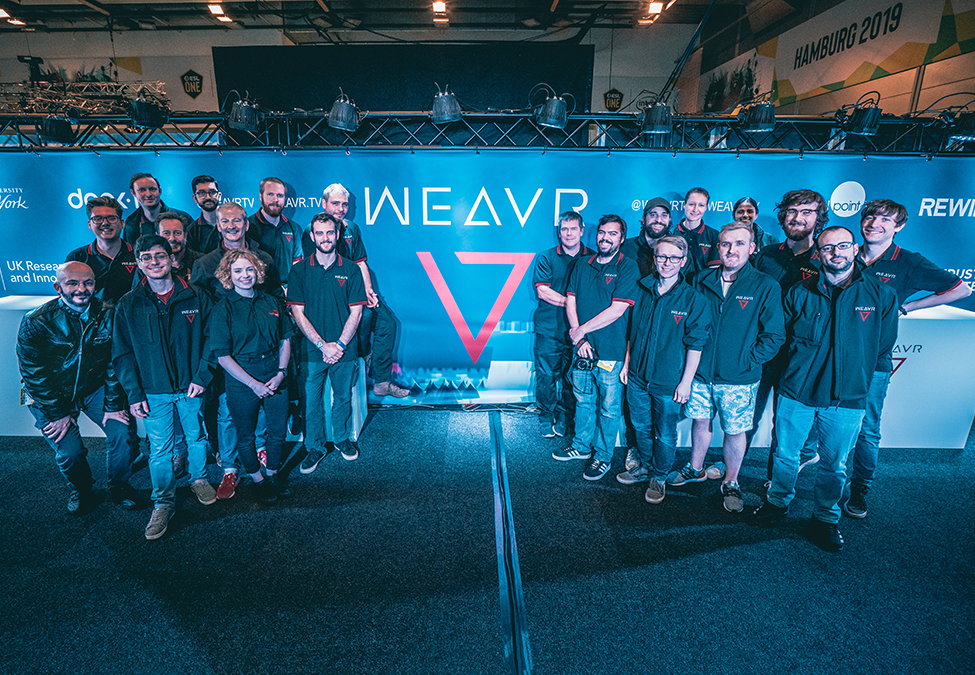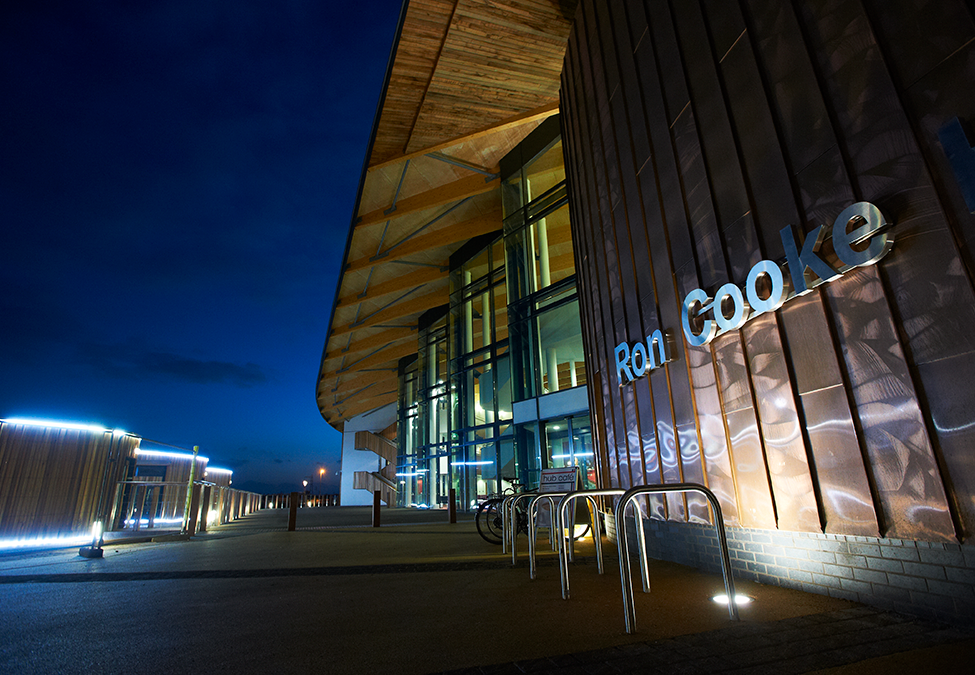The burgeoning growth of esports broadcasting has seen it frequently compared to traditional sports, but esports remains very much its own entity—and it’s one rife with innovation.
Weavr is a perfect example of just that. The technology platform, backed by UK government funding, marries mixed-reality software with esports’ unique potential for data analysis to create one-of-a-kind viewing experiences for esports fans.
In August of last year, the project unveiled its first working prototype, before publicly releasing a mobile application in November.
We caught up with Dr. Florian Block, R&D Director of Weavr and a Research Fellow at Digital Creativity Labs, for his insight into the future esports broadcasting landscape and Weavr’s role within it.

Esports Insider: Last year, Weavr was first announced to the public. Can you share where the project is at now?
Florian Block: We really reached out to the community when we “soft launched” our Android app in Hamburg at ESL One; that was the latest thing. We’ve been doing a lot of data crunching since then and work with the amazing fans on-site and the talents. Based off of that, we’re very close to completing our next major revision of the app. And we’ll start to see some of the virtual studio technology that dock10 is developing for the project.
So, hopefully soon we’ll be seeing an integrated product that looks at all of our interactive experiences for the audience, but that also thinks about tying that in with the coverage and using some really exciting tech in the virtual studios to push the bar. And we’re super excited about that. It’s not too far into the future.
“We’re really trying to add more insights to people and give them a chance to influence a little bit of what they see, what stats to look at, and do all of that in real-time.”
We will launch the mobile app now, fully, on Android and iOS. We’re certainly looking forward to seeing what the community does with it, really. We’re humble servants, we’ve listened, and hopefully it’s produced something that people would like to give a shot.
ESI: Do you have a rough ETA on when the release might be coming?
FB: I will say “within months.” I can’t say specifics yet, I don’t want to do the Blizzard “soon”, you know? [Laughs] But I think we’re very close to showing it in one capacity or another. And then there’s actually probably going to be a lineup of fairly frequent occasions where we can showcase parts of it. But we certainly hope within the next two months.
ESI: What can you tell us about what you’ve added in the latest revision—you mentioned studio integration?
FB: Yeah, this is dock10, in the UK (and really globally) leading and using virtual studios—the things that when you stand in them, it seems like you’re in a green room. But then, when you watch as a viewer, you’ve got this amazing immersive environment that the pundits are in.
And we’re exploring ways we can integrate the sort of data analytics that we get off of our platform for use before and after the match. I can’t really say any specifics yet, but I think we’ll certainly see a start of that very soon. And obviously there’s more down the road; it’s really exciting stuff.
“We’re hoping that we can bring some of the excitement of a big event back, via our technologies.”
The mobile app, as far as that’s concerned, we’re really trying to add more insights to people and give them a chance to influence a little bit of what they see, what stats to look at, and do all of that in real-time—almost live, definitely in sync with the Twitch stream, and giving a bit more control back to the viewers—and personalise that experience as well. That’s also something we’re quite excited about getting into: having some personalised stories come into people’s phones.
The current situation is absolutely awful. It’s a very serious health crisis. But now that we’re in this situation, it’s really hit home the point that lots of people are at home, isolated. Gaming is a major thing, and it’s reinforced my really deep belief in the industry and how games can connect and facilitate, even in exceptional circumstances. And we’ve almost always had the remit to reach the remote audience. Of course, our stuff can be used in the arena too, but we’re really always thinking about the millions of fans sitting at home.
Ironically and somewhat out of a weird turn of events, we are now in a situation where I think the sort of overall innovation we’re trying to introduce is ever more important because in the absence of a stadium event and a physical event, I really think people want to have that special sense that they don’t get just everywhere, for every game. I think they want something special. And we’re hoping that we can bring some of the excitement of a big event back, via our technologies.

ESI: You mentioned the crisis. Has it slowed down your work substantially?
FB: Well, I’d say I feel sorry for my colleagues, who are tied to experimental setups and labs and who have to really travel to do the research, they’re going through a really rough patch. I think we are in a privileged and very lucky position in our team in that we do research with data that is hosted in cloud services on video games that work just like they always work. And so, our experimental setting is basically still there. We’ve always done very applied research and so we are in a very lucky position that we can continue.
Shout-out to the amazing team in Weavr; not just at York, but also across all the different partners. It’s been an incredible experience to see how everyone adjusts. Again, the opportunities that come from the increase in demand for content, I think it’s almost accelerated developments.
ESI: We recently shared an update about the prediction model developed as part of the Weavr project. Can you talk to us a little bit about that and its potential applications?
FB: Yeah, definitely. Obviously, prediction is the very natural thing for the machine learning community to gravitate towards because there’s so much data out there; it’s mathematically interesting.
“When you think about sports and entertainment, you have to be able to anticipate what’s coming next. Otherwise, you can’t be surprised.”
But really, what has excited us about prediction from the start is that… We felt that games such as Dota—and there’s lots of very complex esports around, that have lots of layered complexity with very deep strategy—but this is an experience where the numbers at the top [of the screen] that are suggestive to a score are fairly meaningless. A lot of these numbers have no value in telling the audience who is in favour of winning. And there’s so many things to track during a game.
So, we always felt that prediction is an amazing narrative instrument. For various reasons, not just to tell people, “Hey, these guys are leading.” When you think about sports and entertainment, you have to be able to anticipate what’s coming next. Otherwise, you can’t be surprised. And without surprise—that’s absolutely one of the hallmarks of sports entertainment. You need the element of surprise. So, we think that prediction can have an amazing effect on the viewing experience. I think the industry as a whole is recognising that.
And prediction obviously is interesting in the moment, but you can also use it as an analytical tool, in hindsight. For instance, one of the things that the death prediction almost had as a secondary use—the one that predicts 10 seconds in advance who’s going to die—it inherently was useful to detect highlights. Because afterwards, when the spikes went up, you knew that there was a really high chance of dying and even if people didn’t die, it most frequently pointed towards an interesting event.
We’re really quite excited about the range of different predictions that we’re working on and what they can do for the viewing experience.

ESI: For us, the potential applications within live betting in esports immediately came to mind. That must be something that the folk at Weavr have considered?
FB: Well, it definitely is a commercial opportunity, of course. But, as a consortium, we have not made any active efforts to pursue this opportunity. For us, really, the aspect that stands in the foreground is audience engagement and value to the viewers. We really want to give people an amazing experience on top of the great products that are already out there. And we’d like to do that in a way that would generate value. Most of our business models and what we’re trying to achieve with Weaver is to really give people value, direct value, and betting is a whole different ball game.
ESI: How do you predict the esports viewing experience will evolve over time?
FB: I will start by saying this: we are standing on the shoulder of giants. When you look at individuals and big leading stakeholders like ESL in esports; I mean, the amount of innovation and what they’ve done for esports, long before I even stepped foot into esports personally, is remarkable. But what it also really shows is that esports thrives on innovation, on change, on trying new things, on trying things in a different way.
And since I joined esports four or five years ago, I think that’s slowed down a little, and we always felt that it’s kind of converging towards sports broadcast and professional broadcast—which by no means is a bad thing, but it’s bringing all the old relics back that are very costly, that are very “not esports”, in a weird way. We’re now seeing through the current [Coronavirus] situation that productions are [still] fantastic. The sort of viewership they attract with distributed workflows and people being in different places. And I think it’s almost cutting back to the heart of what esports is.
“10 years from now, I don’t envision people to just sit down and observe, and maybe [use] a little bit of Twitch chat.”
As far as Weavr is going, our vision—what we believe will happen—is that esports will become even more inclusive. I think we’ve come a long way, but there’s more to do. I think both novices and different demographics are now perfectly in reach, and have an appetite to engage with esports. But I also think the way people engage—10 years from now, I don’t envision people to just sit down and observe, and maybe [use] a little bit of Twitch chat. I think that people want to have some degree of control over their experience. Even though it’s a bit buzzwordy, I think personalisation is obviously important, but not just in the way that “if you’re interested in this, you got a little bit more of that.” I think what people want is to completely mash up analysis that they may get about the professional games and then fold that into the data they collect about themselves.
In Dota, everyone has potentially tens of thousands of matches in the history. And I think the appetite is there to really blend this experience of playing and viewing, and not just that, but also people wanting to share more. This sort of whole convergence between players, viewers, and content producers I think is also going to further dissolve. I think we shouldn’t go down the route that traditional sports have been, and I think the exciting thing about esports is there’s this amazing ecosystem out there, millions of people that want to create stuff, not just watch. They want to get engaged, they want to get in there.
And I think that’s how I see esports evolving. I really just think that the way we interact will be much more interactive. I think that’s key.

